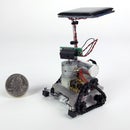Introduction: Clickspace
By adding the element of time into instantaneous computer processes we can visualize the work of algorithms. When computers save your 3D file into the Stereolithography format (STL) for 3D printing they do so one triangle at a time. If one saves an STL in an ASCII format and opens the file in notepad, the index order of the triangles is immediately apparent. The strategy described here adds successively larger Z-heights to the triangles in the order in which they appear in the STL file to reveal the "behind the scenes" meshing process in your 3D modeling software.
The title of this project "clickspace" is a reference to the moment of clicking print, the instance which begins the process of translating our file in various ways. The goal of this project is to open up the moment in time immediately following the clicking of print and to explore this spatially.
The photos above are 3D resin prints of meshes which have been transformed to illustrate the process in which they have been converted from non-triangle models by a meshing algorithm. At the base of the print is the input model (a car, house or mechanism, for instance) and above it is the "time-lapsed" or exploded version of the model with time (or more accurately triangle index) in the Z direction.
Step 1: Download a 3D Model
Grabcad, Thingiverse,and other sites give us access to a large number of beautiful 3D models. Download a file in a format you can work with and then export the file as an Stereolithography File Format (STL) and select ASCII format. Take note of the location of the file because this will need to be input into the Processing script described next.
Step 2: Create a Time-Lapse Mesh Model Using This Processing Script
This Processing script opens up an STL file saved in ASCII format and adds a successively larger Z-height to the triangles in the order in which they have been written to file. Replace my file location information with yours and after the file has been transformed you should be able to reopen it in a 3D modeling program of your choice.
What you should be able to see at this point is a kind of "time-lapse" mesh model. The triangles nearest the bottom were created first and the triangles at the top were created last. By working with simple shapes like spheres one can quickly get an idea for how certain forms have been meshed. Working with more complex models gives more explosive results.
The two parameters to play around with in this script are the sample size (amount of triangles with the same Z-height offset) and the size of the Z-height offset step size. By altering these two parameters the height of the time-lapse model can be controlled as well as the degree to which the model is splintered apart. Think of them as the type of blender setting (chop, emulsify, etc.) and the amount of time you hold down the button for.
Happy exploding!
Attachments
Step 3: Prepare for Objet Printing
To materialize these exploded models I used Pier 9's Objet Printer which allows for printing in multi-material resin. This process requires creating an outer volume (to be printed in clear material) and an STL "explosion" within that volume (to be printed in opaque material). I imported these files as an assembly into Objet Studio and associated the outer volume with Vero Clear material and the mesh with Vero Black material.
In my findings, the exploded mesh first needs to be offset by at least .15mm in order to have sufficient thickness to be printed by the Objet. To avoid optical effects which make the inside of the print blurry I printed these inside a rectangular prism (instead of a cylinder) and tilted the prints to 45 degrees relative to the printing bed.
Step 4: Polish
Here are some great Instructables on polishing resin:
https://www.instructables.com/id/How-to-Polish-Resi...
https://www.instructables.com/id/How-to-polish-3D-p...
I started with 320 grit and went all the way up to 2000 grit with wet/dry sand paper and liberal amounts of water. I finished with buffing and rouge compound. I find the best way to display the prints is on a light table where all of the detail can be appreciated.
Thank you for checking out this Instructable!






